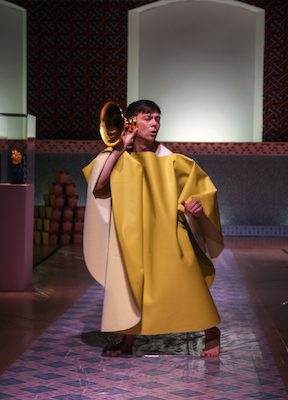As we, the small audience, settled down in the cozy space of Studio 303, the members of Geranium appeared, linked by a wide rainbow-coloured elastic band, to introduce Quantum Fur. Geranium is the joint name of the three curators in residence: Hanako Hoshimi-Caines, Maria Kefirova and Katie Ward.
The evening was composed of four selected works: Stick Kitties by Marc Boucher, Perennial forage by Erin Fortier (both Montréal-based artists), Wampum by composer and artist Elisa Harkins (Cherokee/Muscogee) from Oklahoma and a projection of Milk Pearl by Moine de la non existence de la pensée, a multimedia artist from Belgium. Unfortunately, due to technical difficulty this last work was not presented.
To begin, Boucher, cutting a tall figure in a brown suit, strode gently onstage with a wiry metal mask fastened to a helmet on his head. Rattling clumsily behind him were a series of long, thin metallic rods. “Le temps n’existe pas,” we heard the man say from behind his face piece, and he broke the silence by disturbing the linearity of his metallic rods or “tails” as he later called them, attempting to lift them all at once over his head in a bustle of jabbing corners and falling ends. Eventually, the figure removed his suit to reveal leopard pattern pants (with tail) and crop top, and shortly afterwards a second tall figure entered — Abe Simon Mijnheer in a tuxedo morphsuit. He too was masked with intricate wiry caging fastened to a hockey helmet, but with a white mop hanging at the centre of his visage. Together they composed and decomposed the space with minimalist action and narrative. “Ce, et- là,” said the second figure from behind the round mask. Little by little they shed their cautious decorum (underscored by their obstructed visibility), and a moment later they appeared barefaced singing and lip-synching to German rap music.
Throughout its duration, the piece made use of text and song in a variety of languages and physical narration in a graceful and inquisitive manner highlighted by the anonymity that the face pieces created. But interjected between these poetic scenarios, the string of blundering metal rods clouded any attempt to make sense of what we were seeing. Because of this, I did not perceive or give much importance to a beginning, middle and end. Time did not dictate the logic of the piece, and the whole work, beyond the costumes and props, seemed to be composed of fragments and abandoned material/data. Boucher later said in the talkback, “Trash is our problem.” The work was perplexing in its simplicity, and I caught myself thoroughly entangled within it.
In the second piece, Fortier set a soundscape of crackling and faint conversations emanating from her phone, which was placed on the floor next to a glass fishbowl full of silver sequins and sparkly cloth. She then sat on a tall wooden stool stage left. Over the course of the piece, she emptied the contents of the bowl, hanging the cloths over suspended wooden dowels on either side of the space. Her movement was limited to a repeating sequence of sitting, leaning forward, stretching on the stool, walking around it and the dowels and gazing. However, projected behind her on the wall was herself, sitting on the same yellow-tinted stool but outdoors, among trees on a snowy winter’s day.
The magnified projection of the natural landscape created the illusion that she was outdoors, but the doubling of her stoic gestures onscreen and onstage had something of the timelessness Bouchard was speaking of. Fortier showed more vitality in the outdoor version than onstage, where she was reaching into the bowl and sticking sequins onto her exposed arms and face. Perhaps this gesture was a material expression of that moment or an attempt to recreate that memory. Perhaps this process is a matter of necessity; what serves us at different times influences the gleam of our recollection.
Drawing from her work in neuroscience, Fortier described her piece from the premise that a memory is fully reconstructed every time it is recalled. Though this was not clear to me during the performance, over time (or over memory) Perennial forage, for me, was about the act of recreating — a driving aspect in Fortier’s exploration of how our experiences manifest and construct our memories.
The third work came to us from Oklahoma. Elisa Harkins appeared in a traditional Cherokee tear dress and went directly to the mic, centre stage. She introduced herself and said a few words about her clothing and the songs she would sing (some in Cherokee and others in English). Immediately following this, the lively electro beats of Wampum kicked in, to which Harkins sang short repeating verses, like “Die, don’t die. Get the money” and “Bluebird, bring me peyote,” which she physicalized with deliberate gestures and dance steps simultaneous to every syllable of each song. I was transported to a kind of powwow rave as coloured laser lights went in and out, and Harkins moved incessantly before a white square backdrop of light, with her gaze fixed on the horizon. The language and costume had me convinced that her movement was also culturally specific, but after a while I realized that her sequences were composed of repeating popular modern and disco dance moves (the Wii game Just Dance crossed my mind). She later specified that she had drawn from her training at the Alvin Ailey School and from powwow, African and contemporary styles.
Harkins’ piece had a mesmerizing effect in its repetition that disoriented our sense of time. Her execution was perfectly synchronized and choreographed, but not over-polished and punctuated like so much commercial mainstream dance. The Indigenous-American presence and modern mainstream trends converged into a genre that I see more and more. The results echoed profoundly in Harkins’ work and made me wonder how we preserve ourselves and our cultures in the rapids of constant change. Wampum felt like a bucket of ice water in my face, in the sense that this medium of electronic music that is so alive today and far from subtlety made me look again at a culture that is often situated in the past.
Entering Quantum Fur was confusing at first. From the moment that the curators stepped up, no one in the room was able to settle down into the “performance” dynamic. There was no separating line between the performers and the audience, and at first I was surprised by the informality — as I sat on a low riser reaching for a pillow for extra comfort. Later I realized this lack of demarcation was precisely what allowed audience, curators and performers to be on the same level — exposed, questioning and not passive. The gentle ambiguity had an effect that made us stay awake as people in the room rather than silent receptors. It was an open arena not only for the performing artists but also for the curators, as they fulfilled their task in a self-observant manner, in keeping with the spirit of the selected works: What do we show? Who decides what is shown? Why?
~
A little goes a long way. Donate to The Dance Current today to support bold and inclusive coverage of dance in Canada.
Tagged: Contemporary, Multidisciplinary, QC




